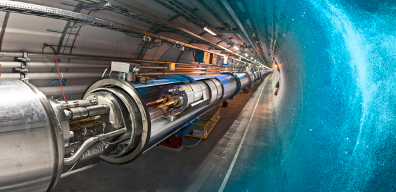Using AI to control energy for indoor agriculture
30 September 2024
Published online 12 April 2015
As the Large Hadron Collider is restarted, physicists suggest mini black holes could be on the horizon.

As preparations are made for the LHC’s next run, a group of physicists from Egypt, Canada and the US have come up with an explanation for why these black holes were not found and predicts that they could be detected soon1. The reason, they claim, is that our current theory of gravity needs to be modified to a model called “rainbow gravity”.
The idea that we could produce tiny versions of cosmic black holes – entities that warp spacetime drastically, swallowing everything nearby – here on Earth was first proposed more than a decade ago2. At that time, two groups of physicists had independently suggested that our universe contains extra spatial dimensions, beyond the three that we experience3 4 , and it is why the force of gravity is so much weaker than the other fundamental forces, such as electromagnetism. They argued that gravity’s strength is reduced because – unlike the other forces – some could be leaking into extra dimensions that are too small for us to perceive normally. “Gravity feels all dimensions,” says physicist Ahmed Farag Ali, at Benha University, in Egypt, and Florida State University, USA.
These theories make an exciting prediction: If extra dimensions are real then it should be possible to create mini black holes at the LHC. These black holes would not be dangerous and would only survive for a fleeting moment, but could be recognized because they would rapidly radiate out particles in every direction, like a firework, as they dissipate. During its first run, however, the LHC ruled out the existence of mini black holes with energies up to about five tera-electronvolts (TeV).
Farag Ali and his colleagues do not think that physicists should be dismayed about the missing black holes. Using an alternative theory of gravity that was first proposed in 20045 – dubbed ‘rainbow gravity’ – they have calculated that if extra dimensions exist, then mini black holes will not be spotted until the LHC hits at least 10 TeV.
Unlike in standard gravity, in rainbow gravity the path through spacetime taken by radiation depends on its energy. Last year, Farag Ali showed that if rainbow gravity models are right, this means that cosmic black holes in space will never fully evaporate as they give out radiation6. Instead they will shrink to a certain minimum size, leaving behind a ‘remnant’.
Now, Farag Ali and colleagues have calculated that the same thing would happen at the LHC, if extra dimensions exist. “It’s only at energies above 10 TeV that mini black holes would spray out matter, making them detectable,” says Farag Ali. “Below that energy, they would just be remnants, which have lost all the properties of black holes and so cannot be recognized.”
The LHC was restarted on 5 April and aims to reach energies of 14 TeV: double that of its first run. “If they find mini black holes above 10 TeV, I think that will be good support for rainbow gravity,” says Farag Ali.
However, Greg Landsberg, a particle physicist at Brown University, Rhode Island, USA – one of the physicists that originally calculated that mini black holes may be produced at the LHC – urges caution. As the LHC ramps up to higher energies, it will become increasingly important to take into account how quantum effects combine with gravity – and that means that any black-hole signatures may be quite different to those previously expected at lower energies.
For instance, black holes could decay into a pair of particle jets, Landsberg says.
Even if such jets were discovered, there may be many different ways to explain their origin -- not just ‘rainbow black holes’.
“Finding a quantum object at 10 TeV decaying in a pair of jets would certainly generate hundreds of papers explaining its possible origin,” says Landsberg.
doi:10.1038/nmiddleeast.2015.66
Stay connected: